Traditional lighting equipment of Japan
The traditional lighting equipment of Japan includes the andon (行灯), the bonbori (雪洞), the chōchin (提灯), and the tōrō (灯篭).
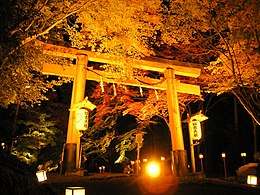
Andon

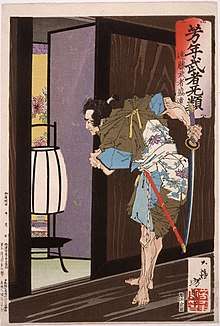
The andon (行灯) is a lamp consisting of paper stretched over a frame of bamboo, wood or metal. The paper protected the flame from the wind. Burning oil in a stone or ceramic holder, with a wick of cotton, provided the light. Rapeseed oil was popular. Candles were also used, but their higher price made them less popular. A lower-priced alternative was sardine oil.
The andon became popular in the Edo period. Early on, the andon was handheld; it could also be placed on a stand or hung on a wall. The okiandon was most common indoors. Many had a vertical box shape, with an inner stand for the light. Some had a drawer on the bottom to facilitate refilling and lighting. A handle on top made it portable. A variety was the Enshū andon. One explanation attributes it to Kobori Enshu, who lived in the late Azuchi-Momoyama Period and early Edo period. Tubular in shape, it had an opening instead of a drawer. Another variety was the Ariake andon, a bedside lamp. The kakeandon under the eaves of a shop, often bearing the name of the merchant, was a common sight in the towns.
The expression hiru andon, or "daytime lamp," meant someone or something that seemed to serve no purpose. In dramatizations of the story of the forty-seven ronin, Oishi Yoshio is often given this description.
Bonbori
The bonbori (ぼんぼり・雪洞) is a kind of Japanese paper lamp used in the open. It normally has an hexagonal profile and is used during festivals.[1] It can either hang from a wire or stand on a pole. Famous is the Bonbori Festival (ぼんぼり祭り, Bonbori Matsuri), held annually at Tsurugaoka Hachiman-gū in Kamakura, Kanagawa. Artists paint on the about 400 bonbori erected for the occasion on the shrine's grounds.[2]
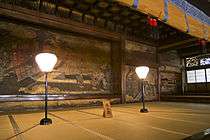 Kō-no-ma 鴻の間, Nishi Hongan-ji, Kyoto
Kō-no-ma 鴻の間, Nishi Hongan-ji, Kyoto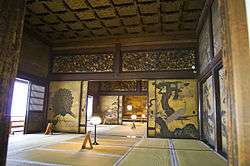 Nishi Honganji, Kyoto
Nishi Honganji, Kyoto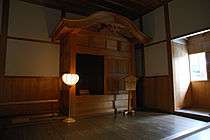 Yōkōkan Teien (養浩館庭園) in Fukui
Yōkōkan Teien (養浩館庭園) in Fukui- Kangetsu-kai 観月会 at Ise Jingū
- Kake-bonbori 懸雪洞, The Mitama Matsuri festival at Yasukuni Jinja
 The Mitama Matsuri festival at Yasukuni Jinja
The Mitama Matsuri festival at Yasukuni Jinja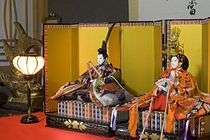
 Hōshi Onsen 法師温泉, built 1895 in Gunma
Hōshi Onsen 法師温泉, built 1895 in Gunma
Chōchin
The chōchin (提灯) has a frame of split bamboo wound in a spiral. Paper or silk protect the flame from wind. The spiral structure permits it to be collapsed into the basket at the bottom. The chōchin hangs from a hook at the top. In present-day Japan, plastic chōchin with electric bulbs are produced as novelties, souvenirs, and for matsuri and events. The earliest record of a chōchin dates to 1085, and one appears in a 1536 illustration.
The akachōchin, or red lantern, marks an izakaya.
- Minatogawa Shrine in Kōbe
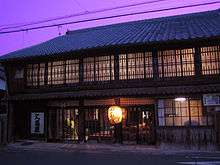 Ōhashi-ya (大橋屋), established in 1649, built 1705 in Aichi
Ōhashi-ya (大橋屋), established in 1649, built 1705 in Aichi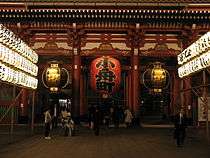
- Yata-dera (矢田寺) Temple in Kyōto
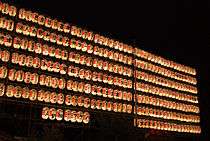 Thousand lights of Cock Festival at Hanazono Jinja in Tōkyo
Thousand lights of Cock Festival at Hanazono Jinja in Tōkyo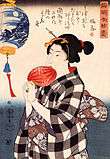 Kuniyoshi Utagawa (1797–1861)
Kuniyoshi Utagawa (1797–1861)- Tenno Matsuri 尾張津島天王祭 in Tsushima, Aichi
- Ikuta jinja in Kōbe
- Saijo-matsuri (西条祭り), Ehime
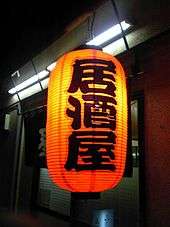 Akachōchin lantern outside an izakaya
Akachōchin lantern outside an izakaya Utagawa Hiroshige (1797–1858)
Utagawa Hiroshige (1797–1858) Gion Matsuri 祇園祭 in Kyōto
Gion Matsuri 祇園祭 in Kyōto Tenjin matsuri 天神祭, Ōsaka Tenmangū Shrine
Tenjin matsuri 天神祭, Ōsaka Tenmangū Shrine
Tōrō
Originally used in the broad sense to mean any lantern, the word tōrō came to mean a lamp of stone, bronze, iron, wood, or another heavy material. These illuminate the grounds of Buddhist temples, Shinto shrines, Japanese gardens, and other places that include tradition in their decor. The earlier oil and candles have given way to the electric bulb.
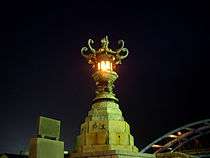 Tasuke Toro 太助灯籠, built 1838 in Kagawa (Kotohira-gū)
Tasuke Toro 太助灯籠, built 1838 in Kagawa (Kotohira-gū) Isuzuchaya 五十鈴茶屋 and Akafuku 赤福, in Ise, Mie
Isuzuchaya 五十鈴茶屋 and Akafuku 赤福, in Ise, Mie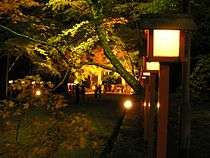 The Momiji Matsuri もみじ祭 festival at Hiyoshi Taisha Shrine
The Momiji Matsuri もみじ祭 festival at Hiyoshi Taisha Shrine Tanzan Shrine in Nara
Tanzan Shrine in Nara

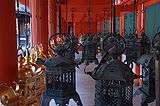 Kasuga-taisha in Nara
Kasuga-taisha in Nara- Kitano Tenman-gū in Kyōto
Other
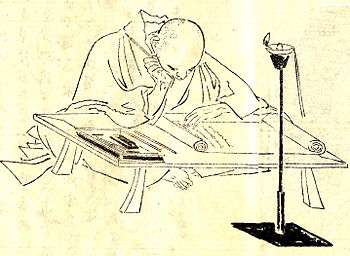 Tōdai (燈臺); slender wooden stand carrying an oil lamp. A tankei (短檠) is a similar form of oil lamp, still used in tea ceremonies.[3]
Tōdai (燈臺); slender wooden stand carrying an oil lamp. A tankei (短檠) is a similar form of oil lamp, still used in tea ceremonies.[3]
References
- Iwanami Kōjien (広辞苑) Japanese dictionary, 6th Edition (2008), DVD version
- "Bonbori Matsuri". Retrieved 8 August 2010.
- "Tankei And Teshoku". 茶の日. Chanobi. 2 January 2017.
See also
- Tōrō nagashi
- Physalis alkekengi, the Japanese lantern plant
External links
- Japanese gardening, Lanterns. Accessed on February 2, 2010